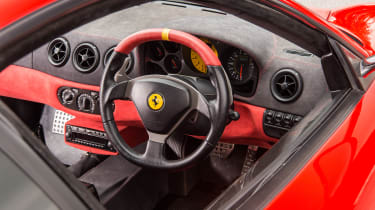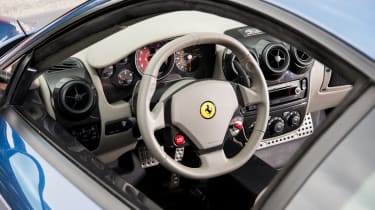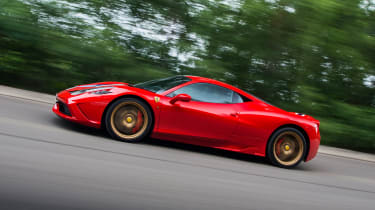Ferrari lightweight specials - 458 Speciale vs 430 Scuderia vs 360 Challenge Stradale
What does the new 488 Pista need to live up to? We revisit its Stradale, Scuderia and Speciale forebears to find out
The mid-engined V8 Ferrari has been a stalwart of the manufacturer's range since the 1970s, with all derivitives sharing the same essential ingredients of a mid-mounted V8 engine, compact body and exotic styling. But where these models were once seen as 'baby' Ferraris, things are a little different now.
In recent times, this bloodline of cars has gained considerable capability. Compromises have been made for the sake of on-road comfort in the standard versions but the modern mid-engined Ferraris, starting with the 360 Modena, have made room for a series of special editions with a little more intensity.
> Click here for all the latest on the new Ferrari F8 Tributo
The hardcore special mid-engined V8 Ferrari has grown to become a recurring sweetspot in the Ferrari range by stripping away the beige leather and sound deadening to reveal the true underlying character of the cars. Below we drive the three hardcore specials that not only defined the genre, but also gave the modern 488 Pista such an illustrious modern heritage to live up to.

Ferrari 360 Challenge Stradale
Challenge Stradale. Sounds good, doesn’t it? Sounds fast; evokes images of racers with number plates on the Targa Florio, tattered bodywork and factory-spec engines, oil-streaked Perspex windows and extra lamps plastered in dead insects. In the case of the 360 CS of 2003-04, it was effectively a road-going version of the 360 Challenge race car used by Ferrari’s one-make series for its V8-engined baby supercar. Less than 15 years ago it seemed daringly cutting edge, shunning the open-gate manual gearbox for Ferrari’s then market-leading semi-automatic ’box, offering 420bhp when that number in itself was a towering figure, particularly from an engine that remained defiantly naturally aspirated.
As I approach the CS today, and open its featherweight door, it seems compact and almost cuddly alongside the militaristic 458 Speciale, let alone the prospect of the new 488 Pista. This is the last of the original V8s, the one we refer to as the ‘Dino’ V8 after Enzo’s beloved son. It can trace its roots right back to prototype racers of the early 1960s, but in ‘F131’ CS tune it displaces 3.6 litres, and with the use of titanium on the inside produces its 420bhp at a furious 8500rpm.
> Ferrari 488 Pista review – can Ferrari's track-focused 488 live up to its illustrious forebears?
The reason the door is so light is because there’s nothing to it but an aluminium skin and a carbon door card. A simple rectangular lever opens it from the inside; the electric window switches are to be found in the middle of the car. Perspex side windows with sliding openers were a factory option – sadly this car doesn’t have them, but plenty didn’t. In fact, so configured – and also without the optional stereo of this car but with its bucket seats – the CS could weigh as little as 1280kg according to Ferrari’s literature of the time.
All is eerily quiet as I take a look around inside. The simplicity of the 360’s interior is so refreshing: the floors are bare metal, the welds on the chassis – not exactly pretty – in full view. What switchgear there is hails from the ’90s Fiat parts bin, but that doesn’t matter, because this isn’t a car to be pontificated on by some smug design critic, or to pamper squidgy posteriors. It’s a driver’s car, pure and simple: emphatically all about the driving.
That simplicity extends to the pre-manettino steering wheel. It’s still a push-button start, but the red button is positioned quaintly down on the centre console, and rouses the engine to a harsh, vibratory blare. Hook first with a tug on the massive right-hand paddle, and hit the Race button – the only real driver mode and the one that makes the gearshift speed at least tolerable by modern standards. From the moment the wheels turn, the CS is all about delicacy. There’s a button for firming up the damping, but you don’t need that on the road, and you can help the gearbox by lifting on shifts executed at anything less than, say, 80 per cent effort. Flat-shifting when you’re really trying works acceptably well; attempting the same in normal driving brings an embarrassing lurch that is best finessed away by the driver. Look on the bright side and call it ‘interaction’.
There’s nothing antiquated about the braking set-up, with the carbon-ceramic brakes being donated by the Enzo. It’s the braking performance that normally dates a classic, but not so here, with the CS stopping with convincing enthusiasm and that characteristically abrasive hiss of ceramic discs and pads generating friction. Most of all, driving the CS is about what you do as a driver. The whole car feels light, a belief fostered by the effortless but very direct steering, but it’s also a car that moves around more on the road than the modern way – grip levels are lower and there’s a much larger grey area between grip and outright slip than you get in something like the Speciale.
There is, of course, much more time to take a course of action in the CS during this phase than in the newer cars, because everything happens more slowly, and that extends to the outright performance, too. Planting your right foot at low-to-middling revs doesn’t produce a thump in the back. The CS needs revs, betrayed by the opening up of the exhaust, to do its best work, and then it feels worth every one of its 400-plus horses, at an exalted rev range that I would happily drive around in all day. It’s a deeply beguiling mix of old and new, the CS, and it sets out the template for this entire bloodline. Four years further on and we have the second instalment of this series – the 430 Scuderia. The ‘Scud’ was a sensation when new, but currently falls into that not-quite-classic, not-quite-new tranche that affects even the most celebrated of cars. Everything is relative, of course, but a 360 CS can be over £200k for a low-mileage example, and a 458 Speciale over £300k, which makes a Scud at just under CS prices conspicuously good value – particularly so, given its performance.
Ferrari 360 Challenge Stradale specs
| Engine | V8, 3586cc |
| Power | 420bhp @ 8500rpm |
| Torque | 275lb ft @ 4750rpm |
| Weight | 1280kg (333bhp/ton) |
| 0-62mph | 4.1sec |
| Top speed | 186mph |
| On sale | 2003-2004 |
| Price new | £133,025 |
| Value today | £140k-240k |
Ferrari 430 Scuderia
The 430 was a heavily developed 360 (with an entirely different engine, much like the 488 is to the 458), and that’s clear from the familiar driving position, the dashboard, the door cards and the overall dimensions of the car, which all exhibit a close similarity with the 360. Like the CS, the Scud feels much, much smaller on the road than the gigantic Speciale, and therefore far more wieldy on British tarmac – even if at 1350kg to the 458’s 1395kg it’s not that much lighter. It’s a bit more luxurious inside than the 360, with leather appearing on some surfaces and more sophistication to the interior design – a sign perhaps that Ferrari was understanding who was actually handing over the money for these more potent versions of its ‘junior’ supercar.
It’s the Scud’s powertrain and electronics that move it on comprehensively from the CS, the Scuderia name more than a subtle hint that this combat-spec Ferrari V8 had direct inspiration from the firm’s Formula 1 efforts. Powered by a higher-revving, titanium-filled version of the standard 430’s V8, this is the F136 motor that shared its fundamentals with sister brand Maserati. You can tell it’s a different engine immediately: there’s the same flat-plane crank harshness at idle, but it emits an instantly recognisable bark at lower revs, a reedy sort of warble that could cut glass. Open the engine up, though, and you’re treated to proper accelerative violence and a savage blast of induction roar, particularly with the side glass lowered. This is the Scud’s 503bhp making itself felt, an astonishing amount from just 4.3 litres of naturally aspirated V8, and frankly worth the price of the car alone.
It feels appreciably faster than the CS, as you’d expect given the power output, but it’s the gearshift that helps, too. The dear old single-clutch ’box had come a long way by 2007, and the shifts are much more convincing in their swiftness, at least in the Race setting. Those settings are accessed by the appearance of the manettino, and with an electronic differential (the E-Diff) and increasingly sophisticated stability control software (F1-Trac), the Scud can be seen as a pioneer of the kind of trickery we’ve come to expect in the modern Ferrari. Essentially, the systems are there not just to keep you on the road, but to make you look good, and let you have fun, all with a safety net in place.
Just as with the CS, there’s a lightness of touch to the Scud. There’s that same flighty but deft character, just with everything that bit more serious, and not just because of the increased speeds. Now Race gathers a lot more different systems together, but there’s the ‘bumpy road’ button to slacken the damping off, and in this configuration it actually rides well, capturing that all-of-a-piece feel that a well-sorted mid-engined car always seems to exude. It does still feel raw, though. The V8 dominates the proceedings, and there’s still the creak and clatter from a pared-back Ferrari cabin of the older generation; don’t go expecting the refinement and build tolerances of a Mercedes S-class if you buy a Scuderia, because particularly at low urban speeds the Scud’s more luxurious leather trim soon feels like little more than a thin facade to the racer underneath.
The more I drive the Scud, the more I wonder if it might be the best of both worlds. This left-hand-drive example is valued at £165,000 by the Octane Collection, and while that’s an awful lot of money, by the standards of the modern supercar it seems like a good deal for a blue-blooded Ferrari such as this one. Most of all, though, it’s the bark of that V8, and the large jump up in torque from the much bigger engine that kicks the car forward in the mid-range (even if this is still an engine that’s all about the revs). It’s a real hooligan, the 430 Scuderia, in a sophisticated, F1-inspired suit.
Ferrari 430 Scuderia specs
| Engine | V8, 4308cc |
| Power | 503bhp @ 8500rpm |
| Torque | 347lb ft @ 5250rpm |
| Weight | 1350kg (378bhp/ton) |
| 0-62mph | 3.6sec |
| Top speed | 198mph |
| On sale | 2007-2010 |
| Price new | £172,605 |
| Value today | £130k-230k |
Ferrari 458 Speciale
The Speciale is something very different. It may feature essentially the same engine as in the 430 – and what an engine – but in all other respects it feels like a car not just six years later, but 16. I know looks are subjective, but let’s face it, the 458 in Speciale trim is an extremely handsome car, and one with real presence, too. After the relative compactness of its two predecessors, the Speciale seems huge, and every inch the modern supercar.
It’s an impression that gains strength as I open the door: the Speciale is on a completely different level to the older cars for design and build quality, even if there’s a 90kg weight saving over the ‘regular‘ 458 Italia. It feels like a beautifully wrought product, and the fact it still has bare floors seems to get lost in the acres of Alcantara and carbonfibre. The dear old F136 V8 is still a physical and audible presence at idle, but it’s not as close by as in the 430. With displacement up to 4497cc, and the rev limit to a stratospheric 9000rpm, this 597bhp masterpiece has the ability to intimidate by reputation even before you’ve squeezed the right-hand pedal (which now operates a vastly more refined and quicker-shifting twin-clutch gearbox).
In fact, the Speciale is no more taxing than a 458 Italia, and the ride quality is astonishingly good – again, with ‘bumpy road’ selected where necessary. Everything the car does is so cohesive, so wonderfully coordinated, that driving becomes almost an extension of your own thoughts and bodily movements.
With nearly 400lb ft of torque and a mass just under 1400kg, the Speciale hardly feels toothless at lower revs. Much has been made of the turbocharged 488’s anytime-anywhere shove, but I don’t feel short-changed driving this car. Open the throttle and it leaps forward; keep your foot in and get the shift lights on the steering wheel blinking and there’s acceleration and a purity of noise that literally takes the breath away. I giggle. I start laughing like a madman and talking to no one in particular. If you’re not moved by the Speciale’s extraordinary performance then we need to check for a pulse immediately.
It’s this wonderful engine that defines the Speciale, even more than its dazzling electronics, active aerodynamics and Side Slip Control 2 (yet another advancement in making the driver feel like a hero at the wheel of an intrinsically dangerous machine, just as the Ferrari Dynamic Enhancer will develop further still with the 488 Pista), and herein lies the thorny topic of debate with all these cars. Whether the Dino V8, the Scud’s rowdy 4.3 lump or the Speciale’s other-worldly device, it’s these naturally aspirated engines that scream ‘Ferrari!’ at you like nothing else can. Not once when driving any of them do I wish for more torque, more driveability, or more performance.
Ferrari may point to emissions regulations for the adoption of turbocharging, but there’s still a very real worry that a major piece of the puzzle will be lost with the new car. In the regular 488 it didn’t seem to matter as much, but when you consider what the Speciale offers, that’s something altogether different. So sharp, so ruthlessly accurate is the throttle at higher revs, there’s a very real sensation of being directly connected to a supreme force, and an inevitable bond between man and machine takes root. It’s a ‘thing’, the Speciale’s V8; it doesn’t require any justification, it just is.
It’s also the last of its kind, unless Ferrari brings its rumoured hybrid tech down from the forthcoming V12 cars and applies it to the mid-engined V8s as well. Whether there’s any way back from the persuasive power and torque outputs enabled by turbocharging is a different matter – in this arena, more than any other, it’s almost impossible to market a less powerful, slower car – and more’s the pity. So it’s probably for the best that we view the Pista as the beginning of a new era, and cap the old one off with the Speciale, the last in a trio of lighter, faster, meaner, more purposeful Ferraris that represent a golden period, not only for the company, but for performance motoring in general.
Ferrari 458 Speciale specs
| Engine | V8, 4497cc |
| Power | 597bhp @ 9000rpm |
| Torque | 398lb ft @ 6000rpm |
| Weight | 1395kg (435bhp/ton) |
| 0-62mph | 3.0sec |
| Top speed | 202mph+ |
| On sale | 2013-2015 |
| Price new | £208,000 |
| Value today | £240k-350k |
With thanks to James Barke for the 360 Challenge Stradale, the Octane Collection for the 430 Scuderia and Adam Smith for the 458 Speciale.














